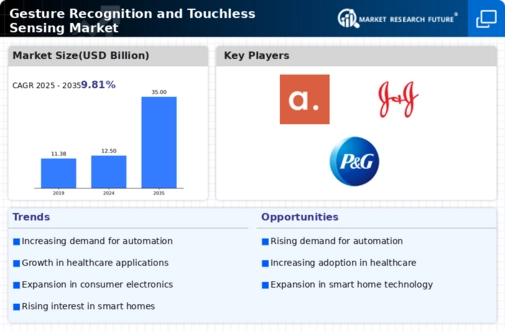Growing Consumer Electronics Market
The gesture recognition-touchless-sensing market is closely linked to the growth of the consumer electronics market, which continues to expand rapidly. With the proliferation of smart devices, there is an increasing demand for intuitive and user-friendly interfaces that incorporate gesture recognition technologies. This trend is particularly pronounced in the smartphone and gaming sectors, where touchless controls are enhancing user experiences. Market analysts project that the consumer electronics market will reach approximately $1 trillion by 2025, providing a substantial opportunity for the gesture recognition-touchless-sensing market industry to capitalize on this growth. As consumers seek more interactive and engaging experiences, the integration of gesture recognition technologies is likely to become a standard feature in new devices.
Rising Demand for Contactless Solutions
The gesture recognition-touchless-sensing market is experiencing a notable surge in demand for contactless solutions across various sectors. This trend is primarily driven by the increasing consumer preference for hygiene and safety, particularly in public spaces. As businesses and organizations seek to minimize physical contact, the adoption of touchless interfaces is becoming essential. According to recent estimates, the market is projected to grow at a CAGR of approximately 25% over the next five years. This growth is indicative of a broader shift towards automation and digitalization, where gesture recognition technologies are being integrated into everyday applications, enhancing user experience while ensuring safety. The gesture recognition-touchless-sensing market industry is thus positioned to benefit significantly from this rising demand, as it aligns with the evolving consumer expectations for seamless and hygienic interactions.
Increased Investment in Smart Technologies
The gesture recognition-touchless-sensing market is benefiting from increased investment in smart technologies across various industries. Companies are recognizing the potential of touchless interfaces to enhance operational efficiency and customer engagement. This trend is particularly evident in sectors such as retail, where businesses are implementing gesture-based systems to streamline transactions and improve customer experiences. Recent data suggests that investments in smart technologies are expected to reach $500 billion by 2026, indicating a robust growth trajectory. As organizations prioritize digital transformation, the gesture recognition-touchless-sensing market industry is likely to see a corresponding rise in demand for innovative solutions that facilitate seamless interactions and improve service delivery.
Regulatory Support for Touchless Technologies
Regulatory support for touchless technologies is emerging as a significant driver for the gesture recognition-touchless-sensing market. Government initiatives aimed at promoting innovation and safety in technology are encouraging the adoption of touchless solutions across various sectors. For instance, regulations that advocate for enhanced safety measures in public spaces are prompting businesses to invest in gesture recognition systems. This regulatory environment is fostering a conducive atmosphere for growth, as companies are incentivized to develop and implement touchless technologies. The gesture recognition-touchless-sensing market industry stands to gain from this supportive framework, which not only enhances market credibility but also encourages further investment and innovation in the sector.
Technological Advancements in Sensing Technologies
Technological advancements in sensing technologies are playing a pivotal role in the evolution of the gesture recognition-touchless-sensing market. Innovations in machine learning, computer vision, and sensor technologies are enhancing the accuracy and responsiveness of gesture recognition systems. These advancements enable more sophisticated applications, from gaming to virtual reality and beyond. For instance, the integration of AI algorithms allows for real-time processing of gestures, improving user interaction and engagement. The market is expected to witness a substantial increase in investment, with projections indicating a potential market size of over $10 billion by 2027. This growth reflects the gesture recognition-touchless-sensing market industry's capacity to adapt and innovate, catering to the diverse needs of consumers and businesses alike.













Leave a Comment